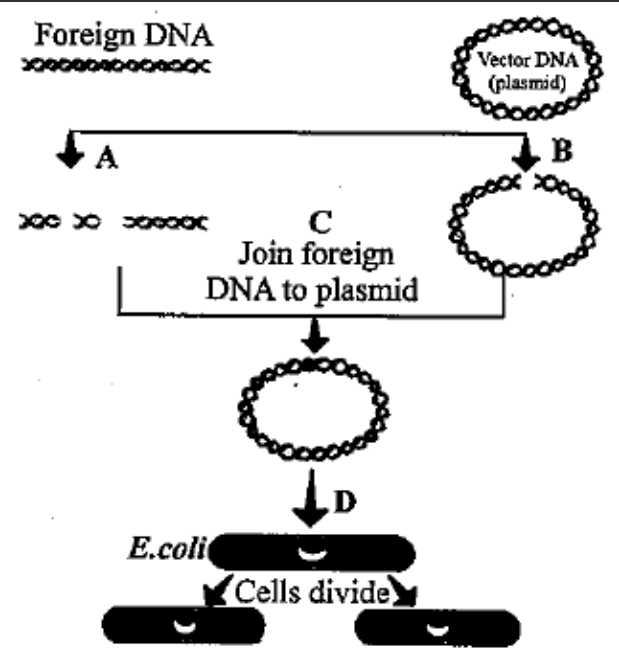Which one is required for protoplast fusion ?
(A) Treatment with cellulase and pectinase
(B) Electrofusion or PEG treatment
(C) Both A and B
(D) Recombinant DNA techology
Treatment with cellulase and pectinase
Electrofusion or PEG treatment
Both A and B
Recombinant DNA techology
The correct Answer is:C
To solve the question "Which one is required for protoplast fusion?", we need to analyze the options provided:
1. Understanding Protoplast Fusion: Protoplast fusion is a technique used in plant biotechnology where the cell wall of a plant cell is removed, resulting in a protoplast. These protoplasts can then be fused together to create hybrid cells.
2. Evaluating Option A:
- Option A states "Treatment with cellulase and pectinase".
- Cellulase is an enzyme that breaks down cellulose, while pectinase breaks down pectin, both of which are components of the plant cell wall.
- This treatment is essential for isolating protoplasts from plant cells, making this option correct.
3. Evaluating Option B:
- Option B states "Electrofusion or PEG treatment".
- Electrofusion involves applying an electric field to induce the fusion of protoplasts, while PEG (polyethylene glycol) is a chemical that can also facilitate the fusion process.
- Both methods are indeed used for protoplast fusion, making this option also correct.
4. Evaluating Option C:
- Option C states "Both A and B".
- Since both Option A and Option B are correct, this option is also correct.
5. Evaluating Option D:
- Option D states "Recombinant DNA technology".
- This technology is not directly involved in the protoplast fusion process, making this option incorrect.
6. Conclusion: Since both Option A and Option B are required for protoplast fusion, the correct answer is Option C: "Both A and B".
Final Answer:
(C) Both A and B
- Option A states "Treatment with cellulase and pectinase".
- Cellulase is an enzyme that breaks down cellulose, while pectinase breaks down pectin, both of which are components of the plant cell wall.
- This treatment is essential for isolating protoplasts from plant cells, making this option correct.
- Option B states "Electrofusion or PEG treatment".
- Electrofusion involves applying an electric field to induce the fusion of protoplasts, while PEG (polyethylene glycol) is a chemical that can also facilitate the fusion process.
- Both methods are indeed used for protoplast fusion, making this option also correct.
- Option C states "Both A and B".
- Since both Option A and Option B are correct, this option is also correct.
- Option D states "Recombinant DNA technology".
- This technology is not directly involved in the protoplast fusion process, making this option incorrect.
(C) Both A and B
Topper's Solved these Questions
- PLANT BREEDING AND DISEASE CONTROLBOOK - DINESH PUBLICATION ENGLISHCHAPTER - PLANT BREEDING AND DISEASE CONTROLEXERCISE - Check your Grasp
10 Videos
- PHYLUM - ARTHROPODABOOK - DINESH PUBLICATION ENGLISHCHAPTER - PHYLUM - ARTHROPODAEXERCISE - CYG
20 Videos
- Plant Growth and MovementsBOOK - DINESH PUBLICATION ENGLISHCHAPTER - Plant Growth and MovementsEXERCISE - BRAIN TEASERS-IV
41 Videos
Similar Questions
Knowledge Check
Given below are a few statements regarding somatic hybridisation. Choose the correct statements.
(i) Protoplasts of different cells of the same plant are fused.
(ii) Protoplasts from cells of different species can fused.
(iii) Treatment of cell with cellulase and pectinase mandatory.
(iv) The hybrid protoplast contains characters of only one parential protoplast.A(i) and (iii)B(i) and (ii)C(i) and (iv)D(ii) and (iii)
Given below are a few statements regarding somatic hybridisation. Choose the correct statements.
(i) Protoplasts of different cells of the same plant are fused.
(ii) Protoplasts from cells of different species can fused.
(iii) Treatment of cell with cellulase and pectinase mandatory.
(iv) The hybrid protoplast contains characters of only one parential protoplast.
View SolutionGiven below are a few statements regarding somatic hybridisation. Choose the correct statements.
(i) Protoplasts of different cells of the same plant are fused.
(ii) Protoplasts from cells of different species can fused.
(iii) Treatment of cell with cellulase and pectinase mandatory.
(iv) The hybrid protoplast contains characters of only one parential protoplast.
View SolutionWhich one yields ATP required for muscle contraction?
(a) Myoglobin
(b) Creatine phosphate
(c) Creatinine phosphate
(d) Myosin
View SolutionModern biotechnology is based on
(a) Protoplast fusion
(b) Tissue culture
(c) Recombinant proteins
(d) Genetic engineering
View Solution(i) A powdered substance (A) on treatment with fusion mixture gives a green coloured compound (B). (ii) The solution of (B) in boiling water on acidification with dilute H2SO4 gives a pink coloured compound (C).
(iii) The aqueous solution of (A) on treatment with NaOH and Br2− water gives a compound (D).
(iv) A solution of (D) in conc. HNO3 on treatment with lead peroxide at boiling temperature produced a compound (E) which was of the same color at that of (C).
(v) A solution of (A) on treatment with a solution of barium chloride gave a white precipitate of compound (F) Which was insoluble in conc. HNO3 and conc. HCl.
Consider the following statement :
(I) Anions of both (B) and (C ) are diamagnetic and have tetradhedral geometray.
(II) Anions of both (B) and ( C) are paramagnetic and have tetrahedral geometry.
(III) Anions of (B) is paramagnetic and that of (C ) is diamagnetic but both have same tetrahedral geometry.
(IV) Green coloured compound (B) in a neutral of acidic medium disproportionates to give (C ) and (D).
Of these select the correct one from the code given :
View SolutionGiven below are different steps of transformation in a bacterial cell. Arrange them in correct sequence. (i) Heat shock (at 42°C) (ii) Treatment of bacterial cell with divalent cations at 4°C (iii) Bacterial cells are incubated with recombinant DNA on ice (iv) Recombinant/Transformed bacteria are plated and kept at 37°C
View SolutionThe flow chart given below represents the process of recombinant DNA technology. Identify A,B, C and D.

View Solution
